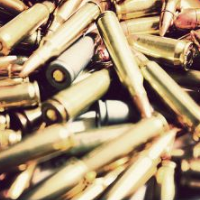Can Condors Last until State Lead-Bullet Ban Kicks in Five Years from Now?
 (photo: Rudy Lara, Flickr)
(photo: Rudy Lara, Flickr)
California lawmakers have outlawed lead bullets for the killing of wildlife, and new condor cams can give a bird’s-eye view of the majestic creatures. Now, they just have to stay alive long enough until the law takes full effect in 2019.
That may be a problem.
The Los Angeles Zoo and Botanical Gardens, a partner in the California Condor Recovery Program since the 1980s, announced that it treated a record 21 condors for lead poisoning in October. The birds were brought to the Gottlieb Animal Health and Conservation Center at the zoo by the U.S. Fish and Wildlife Service.
“It’s scary to see so many clinically sick birds,” Dr. Curtis Eng, chief veterinarian and manager of the zoo’s condor program said.
Lead exposure is considered such a threat to the once-nearly extinct birds that California condors are routinely trapped twice a year and blood-tested in the field. If they come up positive for lead, they are sent to a facility for more testing and treatment. Most birds respond positively to treatments and are back in the wild within three weeks. But those are, by and large, the ones that don’t show symptoms of poisoning.
But this time, the birds are visibly sick and not eating, which End said is unusual. Three of the birds were critically ill when brought in. The 21 poisoned birds are nearly half of what the zoo typically treats in a given year.
The world population (pdf) of California condors has climbed to more than 430 after reaching a low of 22. About half of those are in the wild and around 130 fly free in California. Condors were listed as a federally endangered species in 1967, but it was two decades before measures were taken to save them.
Chief among the threats to the birds are the use of lead bullets by hunters. Conventional wisdom and accepted science blames lead ammunition for poisoning millions of animals that weren’t shot, but who ate animals that were.
Governor Jerry Brown signed Assembly Bill 711 last month, which makes California the first state to require hunters to use non-lead ammunition. It expands a 2007 law that banned the use of lead bullets in the eight counties frequented by condors. That law was widely deemed ineffective.
The National Rifle Association (NRA) took that failure as evidence that lead bullets weren’t a threat to condors. The NRA believes the lead widely found in dead and ailing animals comes from other sources because lead is in everything from paint to pesticides. Lead is a dangerous toxin and has been banned in toys, paint and gasoline.
The NRA launched its Hunt for Truth website and fought the legislation hard, winning a delay in its implementation. The law will be phased in, beginning in 2015.
–Ken Broder
To Learn More:
Assembly Bill 711 May Reduce Future Treatments (Los Angeles Zoo)
LA Zoo Treats 21 Condors for Lead Poisoning (Associated Press)
Record 21 California Condors Treated at L.A. Zoo for Lead Poisoning (by Alicia Banks, Los Angeles Times)
Scientists Fight to Save Condors from Lead Bullets (by Peter Fimrite, San Francisco Chronicle)
With Ban on Lead in Hunters’ Bullets, California Hopes to Protect Condors (by Lenny Bernstein, Washington Post)
NRA’s “Hunt for Truth” about Lead Ammunition Leads to California Zoos (by Ken Broder, AllGov California)
- Top Stories
- Controversies
- Where is the Money Going?
- California and the Nation
- Appointments and Resignations
- Unusual News
- Latest News
- California Forbids U.S. Immigration Agents from Pretending to be Police
- California Lawmakers Urged to Strip “Self-Dealing” Tax Board of Its Duties
- Big Oil’s Grip on California
- Santa Cruz Police See Homeland Security Betrayal in Use of Gang Roundup as Cover for Immigration Raid
- Oil Companies Face Deadline to Stop Polluting California Groundwater





